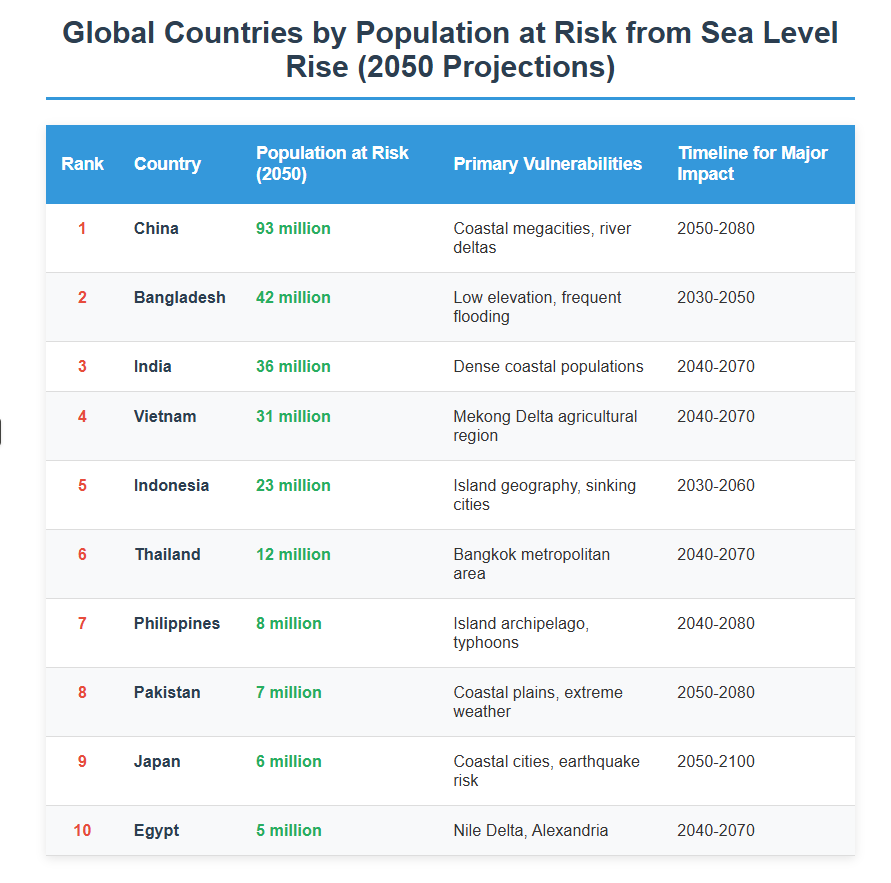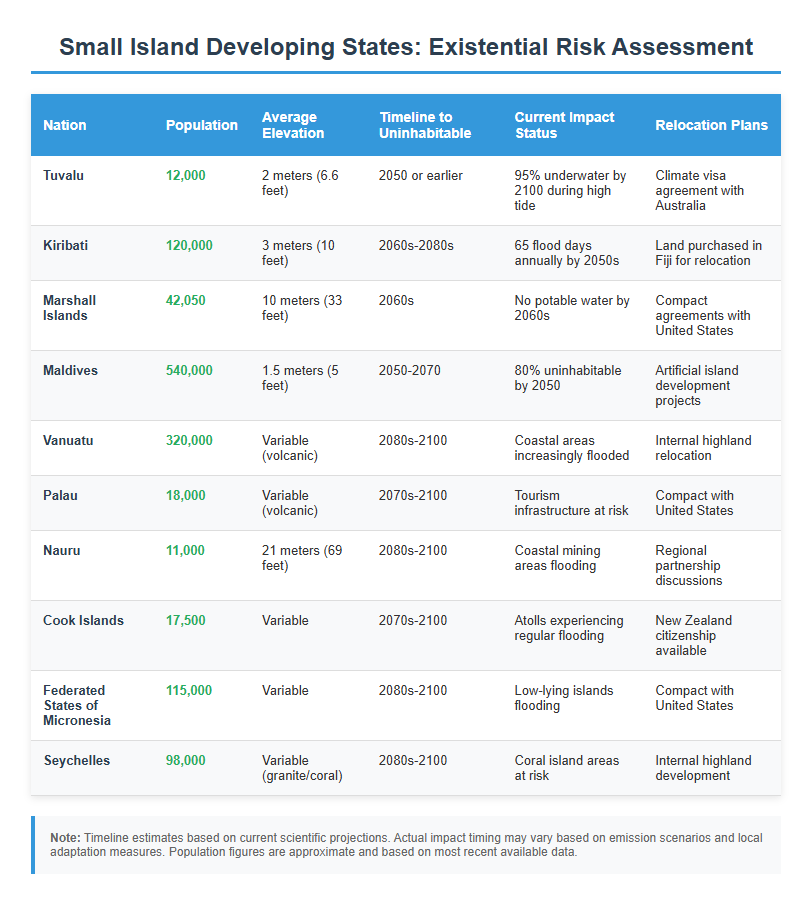Samut Prakan, Thailand
Summary
This was the first AI report generated using recent studies for a long-term real estate and business risk mitigation plan concerning flooding. I find it less than objective for my purposes. So I take it with a grain of salt, as AI can make mistakes. While it may impact many people in Florida, Louisiana in the long-term, I am pretty sure I’m in the safe zone despite my place being 50′ above the waterline in Whittier, AK. Though tsunami and water contamination are more likely in the near-term. Most projections show more drastic effects of rising levels and flooding on the 20+ year horizon. By that time, I’ll have already stopped engaging in risky real estate pursuits.
That said, the United States could face an unprecedented coastal crisis as accelerating sea level rise, driven by climate change feedback loops, threatens to fundamentally reshape American coastlines within the next 25-75 years. Current projections, which may significantly underestimate actual impacts due to tipping points and feedback mechanisms, indicate that tens of thousands of square miles of U.S. land will be permanently lost to rising seas, displacing millions of Americans and causing trillions in economic damage.
As people have been saying for the past 40 years, California will one day be underwater.
Key Findings:
- Immediate Threat (2050): 388-536 square miles of land lost in 32 major cities alone
- Accelerated Scenario: Up to 28,800 square miles of U.S. land could be lost with 10 feet of sea level rise
- Population at Risk: 12.3 million Americans currently live on land that would be submerged under accelerated scenarios
- Economic Impact: Over $106 billion in coastal property will be below sea level by 2050
Current Sea Level Rise Rates and Acceleration
Historical Context
Global average sea level has risen 8-9 inches since 1880, with the rate more than doubling from 0.06 inches per year in the 20th century to 0.14 inches per year from 2006-2015. However, recent research from Hong Kong Polytechnic University shows the rate has accelerated to approximately 3.3 mm (0.13 inches) per year, with 90 mm of rise between 1993 and 2022.
Projected Acceleration
- Conservative Scenario: 10-12 inches of rise along U.S. coastlines by 2050
- High Emissions Scenario: 2.2 meters (7.2 feet) by 2100, 3.9 meters (13 feet) by 2150
- Regional Variations: Gulf Coast faces fastest rise at 19.3-27.2 inches by 2050
Critical Feedback Loops and Tipping Points
Ice Sheet Instability
Current projections may drastically underestimate actual sea level rise due to several accelerating feedback mechanisms:
Marine Ice Sheet Instability (MISI): As ice shelves thin from warm ocean water, ice streams accelerate, creating positive feedback loops where retreat exposes more ice to melting. The Thwaites “Doomsday Glacier” already accounts for 4% of global sea level rise and may collapse within decades.
Temperature Thresholds: Early models suggested 3°C of warming would destabilize Greenland’s ice sheet, but recent estimates indicate this could occur at just 1.5°C – a threshold we may already be approaching.
Permafrost Carbon Feedback
Permafrost contains approximately 1.4 trillion metric tons of carbon – nearly twice the amount currently in the atmosphere. As Arctic regions warm, thawing permafrost releases both CO₂ and methane, creating a feedback loop that could contribute an additional 0.5°C of warming by 2100.
Current Evidence: Permafrost regions are already releasing 0.3-0.6 Pg of carbon per year to the atmosphere, suggesting the feedback mechanism is already underway.
Land Subsidence Acceleration
Coastal land subsidence (sinking) compounds sea level rise impacts. Research shows 24 of 32 major U.S. coastal cities are sinking more than 2 millimeters per year, with half sinking faster than global sea levels are rising.
Timeline for Major Coastal Relocations
Phase 1: Immediate Impact (2025-2050)
- 2050 Threshold: 1 in 50 people in coastal cities will experience significant flooding
- Population Affected: Up to 500,000 Americans
- Property Impact: 1 in 35 privately owned coastal properties damaged
- Infrastructure: 2,400 miles of Gulf Coast roadway at risk of permanent flooding
Phase 2: Mass Displacement (2050-2100)
- New Orleans Region: Over 500,000 people projected to flee seven-parish area by 2100
- National Scale: Potential displacement of millions from tens of thousands of square miles
- Economic Disruption: Coastal infrastructure, military bases, and energy facilities increasingly uninhabitable
Phase 3: Accelerated Collapse (2100-2150)
Under high emissions scenarios with ice sheet collapse, the displacement timeline could compress significantly, with catastrophic impacts occurring decades earlier than currently projected.
Top Affected U.S. Cities: Land Loss and Population Impact
Most Vulnerable Cities by Population at Risk
| Rank | City | Current Population on Affected Land | Projected Land Loss (10 ft scenario) | Key Vulnerabilities |
|---|---|---|---|---|
| 1 | New York City | 703,000 | Extensive Manhattan/Brooklyn flooding | Subway system, financial district |
| 2 | New Orleans | 342,000 | Majority of city below sea level | Already subsiding, hurricane exposure |
| 3 | Miami | 275,000 | South Beach and downtown core | Groundwater infiltration, real estate |
| 4 | Hialeah, FL | 224,000 | Western Miami-Dade flooding | Low elevation, dense population |
| 5 | Virginia Beach | 195,000 | Oceanfront and inland areas | Military installations, tourism |
| 6 | Fort Lauderdale | 160,000 | Coastal and inland waterways | Port facilities, airport |
| 7 | Norfolk | 157,000 | Historic downtown, naval base | Critical military infrastructure |
| 8 | Stockton, CA | 142,000 | Sacramento Delta system | Agricultural disruption |
| 9 | Metairie, LA | 138,000 | Jefferson Parish suburbs | Hurricane evacuation routes |
| 10 | Hollywood, FL | 126,000 | Intracoastal waterway areas | Tourism infrastructure |
Regional Land Loss Projections
Gulf Coast (Highest Risk)
- Louisiana: Already lost over 2,000 square miles (1932-2016), primarily wetlands
- Texas Gulf: 106 square miles lost in single Hurricane Ida event
- Projected Additional Loss by 2050: 500-700 square miles across region
Atlantic Coast
- Historical Loss (1996-2011): 20 square miles converted to open water
- Projected Loss by 2050: 300-370 square miles on East Coast alone
- Most Affected States: Florida, North Carolina, Virginia, New York, New Jersey
Pacific Coast
- California: Moderate impacts due to tectonic uplift in some areas
- Projected Impacts: Concentrated in San Francisco Bay and Los Angeles coastal areas
Economic and Infrastructure Impacts
Property and Infrastructure at Risk
- Coastal Property Value: Over $1 trillion located within 700 feet of coast
- Transportation: 60,000+ miles of roads and bridges in coastal floodplains
- Energy Infrastructure: 300 energy facilities within 4 feet of high tide line
- Military Assets: Multiple major bases along all three coasts
Adaptation Costs
- Protection Costs: $14 trillion annually by 2100 under high-emission scenarios
- Property Relocation: $20-150 billion for 50cm sea level rise by 2100
- Infrastructure Rebuilding: Trillions in roads, utilities, and facilities
Social and Environmental Justice Impacts
Research reveals that sea level rise impacts disproportionately affect vulnerable communities:
- Racial Inequality: Gulf Coast impacts fall disproportionately on minority communities
- Economic Disparity: Affected properties often have lower values than city medians
- Compounding Vulnerabilities: New Orleans and Port Arthur, Texas show intersection of racial and economic disadvantages in highest-risk areas
Recommendations and Conclusions
Immediate Actions Needed (2025-2030)
- Updated Coastal Planning: Incorporate land subsidence data into all flood resilience plans
- Infrastructure Hardening: Elevate or relocate critical facilities in highest-risk areas
- Early Warning Systems: Implement comprehensive flood monitoring and evacuation planning
- Equitable Adaptation: Prioritize resources for vulnerable communities
Long-term Strategic Response (2030-2050)
- Managed Retreat: Develop federal programs for voluntary relocation from highest-risk areas
- Regional Migration Planning: Prepare inland areas for climate migration influx
- Economic Transition: Support coastal communities in transitioning away from vulnerable industries
- Ecosystem Restoration: Invest in natural barriers and wetland restoration where feasible
Critical Knowledge Gaps
Current projections likely underestimate impacts due to:
- Incomplete modeling of feedback loops and tipping points
- Limited integration of land subsidence data
- Uncertain ice sheet collapse timelines
- Cascading infrastructure failure effects
Bottom Line
The United States faces a coastal transformation unprecedented in modern history. Without immediate, comprehensive action to both mitigate emissions and adapt coastal communities, millions of Americans will face forced relocation from tens of thousands of square miles of lost land within the next 25-75 years. The window for proactive adaptation is rapidly closing, making coastal resilience planning one of the most urgent national security and humanitarian challenges of the 21st century.
This report synthesizes data from NOAA, NASA, EPA, Virginia Tech, Hong Kong Polytechnic University, and peer-reviewed climate research published in Nature, Science, and PNAS journals. Population and land loss estimates are based on current best-available science but may significantly underestimate actual impacts due to accelerating feedback mechanisms.


Recent Comments